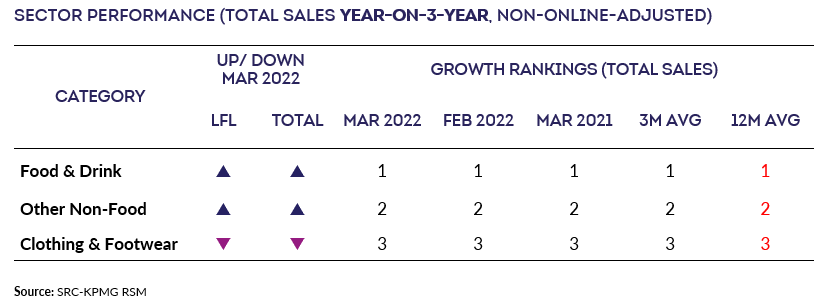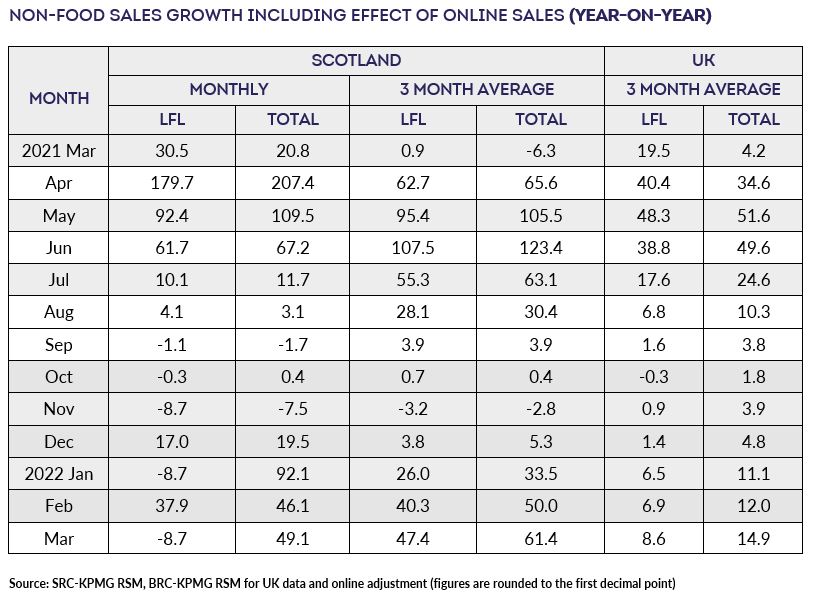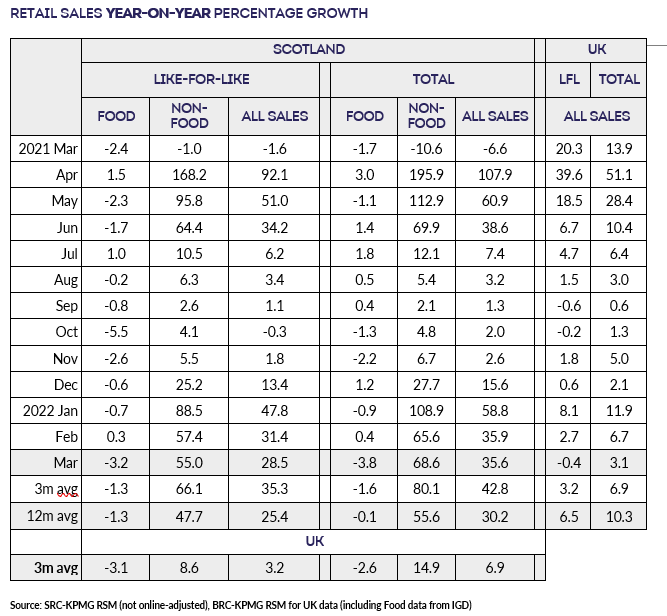During the pandemic much of retail bounced between being open and
closed, significantly impacting sales and changing consumer
behaviours. In March 2020, non-essential retail stores began to
close and in March 2021, Scottish retail was in lockdown, pushing
many consumers to buy goods online. In this context, all
comparisons are provided on a year-on-3-year
(Yo3Y) basis, we have also included comparisons
with March 2021 (YoY), where relevant. This will be
clearly signposted below.
Sales figures are not adjusted for inflation. Given that both the
March SPI (BRC) and February CPI (ONS) show inflation running at
historically high levels, a portion of the sales growth will be a
reflection of rising prices rather than increased volumes.
Covering the five weeks 27 February – 2 April
2022
- Total sales in Scotland increased by 0.6% compared with March
2019 (Yo3Y), when they had grown by 0.3%. This was above both the
3-month and the 12-month average decreases of 3.2% and 7.3%,
respectively.
- Scottish sales increased by 0.7% on a Like-for-like basis
compared with March 2019 (Yo3Y), when they had decreased by 0.2%.
This is above the 3-month average decrease of 2.1% and the
12-month average decrease of 4.7%.
- Total Food sales increased 6.0% versus March 2019 (Yo3Y),
when they had decreased by 0.2%. March was below the 3-month
average growth of 6.2% and above the 12-month average growth of
4.1%. The 3-month average was below the UK level of 9.2% on a
3-year basis.
- Total Non-Food sales decreased by 3.9% in March compared with
March 2019 (Yo3Y), when they had increased by 0.7%. This was
above the 3-month average decrease of 11.0% and the 12-month
average decrease of 16.9%.
- Adjusted for the estimated effect of Online sales, Total
Non-Food sales decreased by 23.4% in March versus March 2019
(Yo3Y), when they had increased by 1.3%. This is above the
3-month average decline of 29.6% and the 12-month average
decrease of 24.0%.
Ewan MacDonald-Russell, Head of Policy | Scottish Retail
Consortium
“March sales sparkled compared to recent months as shoppers
returned to spending. This is the first time sales have been
close to pre-pandemic levels since the Covid crisis hit and
coincides with the removal of nearly all Scottish Covid
restrictions. However, these improved figures are at least in
part a result of rising shop prices as retailers grapple with a
host of inflationary costs.
“Food sales rose by six percent in March driven by higher
inflation alongside customers focusing more on eating at home
than at eateries. The first Mother’s Day in three years where
Scots could visit family led to strong food sales as well as a
boost for fashion and beauty lines. Retailers also noted the
endemic supply challenges had eased slightly this month; helping
furniture and electrical shops.
“Whilst these sales figures are encouraging, the economic storm
clouds continue to concern retailers. Costs continue to rise and
will worsen in April as non-domestic rates bills return for many
retailers. Rising inflation means prices are likely to continue
rising, which will put immense pressure on households
discretionary spending which has significant implications for
many retailers.”
, Partner, UK Head of
Retail | KPMG
“Retailers will be glad to see sales in
Scotland reach pre-pandemic levels for the first time since the
health crisis began. While this is promising, it’s too early to
call this a return to normality given the cloud of geopolitical
and macro-economic uncertainty which has the potential to dampen
consumer confidence and spending power in the months ahead.
“As households feel the pressure, retailers are facing their own
battle with rising costs and inflation, and are walking a
tightrope between absorbing rising costs themselves or passing
these on to consumers. Successful retailers will continue to
maintain a clear understanding of their customer, what they want
to buy and how, whilst balancing attention on areas that can
yield cost and efficiency gains. It remains to be seen whether or
not consumers will reduce physical and virtual spending to offset
rising household bills and reduced household incomes.”



